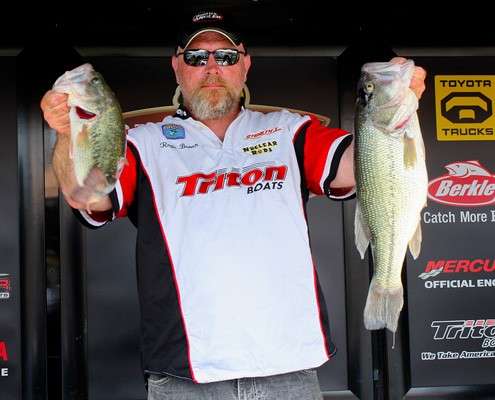
I caught her about 8:30 on Thursday morning. It was my third stop of the day. She was in a school of bass holding on the side of a main lake point in about 25 feet of water. The spot was fairly ordinary except that it had several big rocks scattered around.
The spot was good. That was a given. I caught a 5 pounder on my first cast to it in practice. But I also said it was ordinary. What I meant was that it was the typical kind of spot you’d find bass in a reservoir at this time of the year — deep, offshore, holding on something a little different.
My bait was a Big Bite 10-inch Red Bug Kriet Tail Worm, Texas rigged. My basic technique was to carefully position my boat and throw past the school. I hopped it along with sharp upward jerks and short pauses on the bottom until it was into the school. The big bass bit on the far outside edge of the group of bass.
I don’t like to throw directly into the school. I don’t want to startle them or make them skittish. All I want to do is pick off the ones that are feeding. My sinker was a common 3/8-ounce bullet-type weight. My hook was a 6/0 Gamakatsu SuperLine Offset EWG. I was fishing a big bait and looking for a big bass. I wanted a big, strong hook.
I used a 7 foot, 6 inch extra-heavy Nuclear rod. (They're a relatively new company doing business here in Tennessee and around the South.) My reel was a Shimano Calais (6.2:1 gear ratio) and my line was 16-pound-test Sunline Fluorocarbon.
There are several lessons from this catch:
1. At this time of the year, you should fish deep offshore structure. That means spending the time to learn how to find it with your electronics. There may be fish shallow, but the majority of the tournament winners are deep.
2. Use a big lure. I don’t argue the point that you can catch big fish with a 4-inch bait. But, you’ll catch more big ones if you upsize to a 10-inch worm.
3. Carefully position your boat. Each cast has to be precise. I knew where the rocks were, and I knew where the fish were. I was able to throw past them and then fish back towards them. I honestly think that’s why I caught her.
Constant maneuvering puts a lot of strain on your deep cycle batteries. I use a Stealth 1 Charging System. It charges the trolling motor batteries at the same time it charges the cranking battery — when the big motor is running. I can move around all day with no loss of power. That’s a huge advantage.




